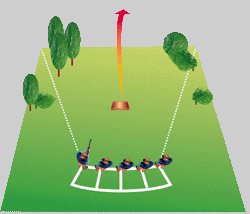TRAP SHOOTING
How to Shoot a Game of Trap
Trap is the most popular shotgun shooting sport in America with some 55,000 active shooters that shoot an estimated 82.5 million registered targets per year. There are three basic types of trapshooting—the 16-yard event, handicap and doubles. Following is a description of each type:
Singles: Singles is considered to be the easiest of the three disciplines. In singles, the shooter stands 16 yards away from the center of the “trap house” and shoots at random targets that fly at various angles in front of him/ her. Shooters are grouped into squads, usually made up of up to five people. There are five positions that each shooter shoots from, for a total of five shots, or one round. This gives participants a different view of the target flying through the air. Each position is a constant 16 yards from the trap house, each one is spaced three feet apart forming a small arc. Squads rotate between four trap fields called a “bank.” When the shooter is finished shooting at targets from those four trap houses, they have completed a round of 100 targets, 25 at each bank. The premier shooting event in singles is the ATA Clay target Championship.
Doubles: Doubles was added to tournament play in 1911. It is a modified version of Singles, but it is more difficult because shooters must break two targets launched from the trap house simultaneously. One clay pigeon flies to the left while the other flies to the right. The target path remains constant, but the challenge is if the shooter can hit both targets before they hit the ground. Each target is scored individually, not as a pair. There are no partners in doubles. Some shooters tend to use a shotgun with two barrels for doubles and one with one barrel for singles and handicap.
Handicap: Handicap is considered the most prestigious event in trapshooting. As in other sports, handicapping strives to make the competition equal. The is accomplished by having the more skilled competitors stand further away from the trap house. Based on a shooter’s past performances, a shooter is assigned a handicap distance which he/she must shoot. A competitor with a high handicap will shoot no closer than the 19 yard line, while the most skilled shooter is placed at the 27 yard line. It is extremely difficult to win an event from the 27 yard line. Only twice in the last ten years has a Grand American Handicap champion been a 27 yard shooter.
EQUIPMENT
Firearms: The typical gun for trapshooting is a 12-gauge with full or improved-modified choke and ventilated rib barrel 30-32 inches long. Although many top trap shooters favor over/under shotguns, single barrel, pump and autoloading shotguns are also common. Registered trap is always shot with a 12-gauge shotgun.
Ammunition: The shotshells used in trapshooting may vary slightly with shooters preference and wind conditions. The standard load contains 3 drams equivalent of powder and 1-1/8 ounces of # 7-1/2, 8 or 8-1/2 shot. Loads with only one ounce of shot are also popular.
Targets: Regulation targets measure not more than 4-5/16 inches in diameter and 1-1/8 inches in height, weighing 3-l/2 ounces. They are composed of pitch and clay or limestone, are saucer-shaped and painted black with bright orange or white crowns.
How To Shoot Trap: Station 3
How to Shoot Trap: Station 5
American Trap Shooting Tips
HISTORY
Trap Shooting derives its name from the device which throws the clay targets into the air. Trap simulates the flight of a gamebird flushed ahead of the shooter and, in fact, in the original version of the sport, live birds were released from holes in the ground covered with silk top-hats. The first mention of trapshooting as a sport is found in a circa 1793 English publication titled “Sporting Magazine”.
The practice of shooting live birds from traps was first introduced in the U.S. in 1831 by the Sportsmen’s Club of Cincinnati, Ohio. Targets first replaced live birds about the time of the Civil War. Early varieties of targets, designed to duplicate a live bird, included a metal “bird” with rotary wings and fragile, feather-filled glass balls launched from traps resembling medieval catapults. In the 1880s, clay targets such as the ones used today were first developed, with George Ligowskey of Cincinnati credited with creating the first clay target and trap.
The first Grand American Handicap was held in 1900 in Queens, Long Island New York and was the beginning of what has become the nation’s most renowned shooting tournament. Between 1900 and 1924, the tournament site shifted annually—Chicago hosted the event nine times and The Grand was also held in Indianapolis, Kansas City, Cleveland, Atlantic City and St. Louis. In 1924, Vandalia, Ohio, a suburb of Dayton, became the permanent home of The Grand. During that first tournament, 400,000 targets were trapped—today, over 4-1/2 million are thrown. Almost 6,000 participants travel to Vandalia each August to participate in the 10-day tournament.
Trap at the Coeur d’Alene Skeet and Trap Club
The club has two voice activated traps that throw regulation birds for singles, handicap and doubles practice. Coeur d’Alene Skeet and Trap holds two league tournaments for members annually; the largest of which is our 12 week winter league shoot. League shoots are handicapped to event the playing field amoung different levels of shooters.
For complete rules and regulations governing trapshooting contact:
The Amateur Trapshooting Association
601 W. National Road
Vandalia, OH 45377
Tel: (513) 898-4638 Fax: (513) 898-5472
For more instruction on how to play skeet and trap games, please visit:
Illustration provided by Clay Shooting Magazine
Copyright © 2019 Coeur d’Alene Skeet & Trap.



